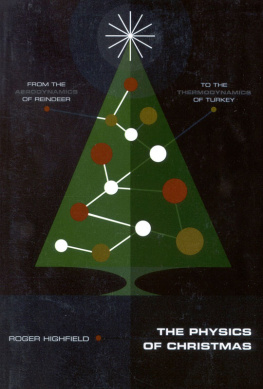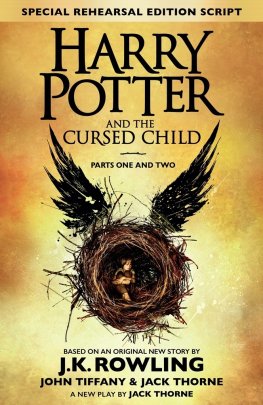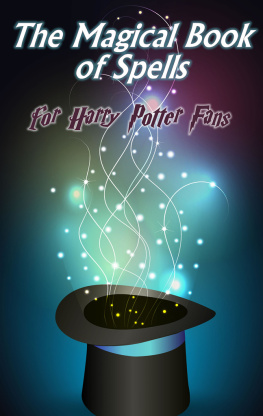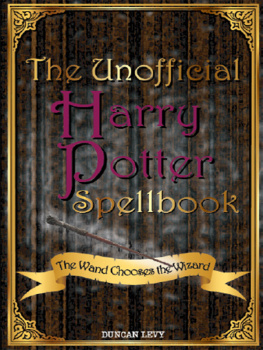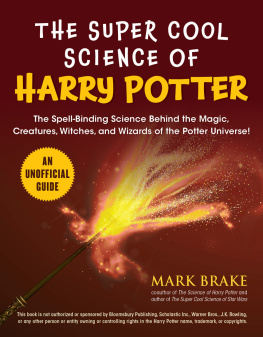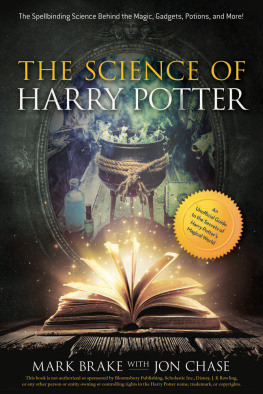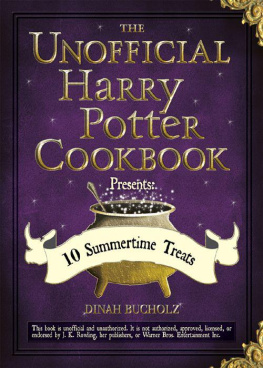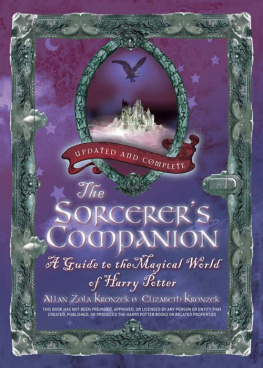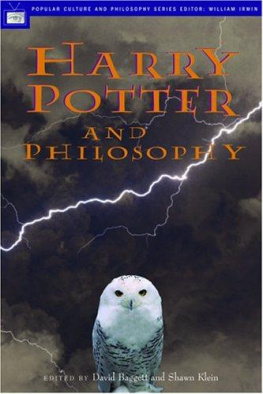Table of Contents
PENGUIN BOOKS
THE SCIENCE OF HARRY POTTER
Dr. Roger Highfield is science editor of The Daily Telegraph, which has published several thousand of his articles since 1986. A regular broadcaster on the BBC, a member of a Royal Society committee on science and society, and the winner of several journalism awards, Highfield is the author of The Physics of Christmas and the coauthor of such acclaimed books as The Arrow of Time and The Private Lives of Albert Einstein. He lives in London.
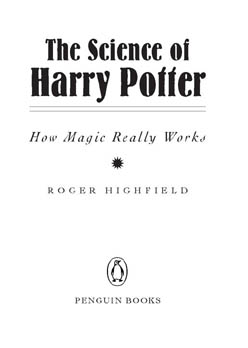
PENGUIN BOOKS
Published by the Penguin Group
Penguin Group (USA) Inc., 375 Hudson Street,
New York, New York 10014, U.S.A.
Penguin Books Ltd, 80 Strand, London WC2R 0RL, England
Penguin Books Australia Ltd, 250 Camberwell Road,
Camberwell, Victoria 3124, Australia
Penguin Books Canada Ltd, 10 Alcorn Avenue,
Toronto, Ontario, Canada M4V 3B2
Penguin Books India (P) Ltd, 11 Community Centre,
Panchsheel Park, New Delhi-110 017, India
Penguin Books (N.Z.) Ltd, Cnr Rosedale and Airborne Roads,
Albany, Auckland, New Zealand
Penguin Books (South Africa) (Pty) Ltd, 24 Sturdee Avenue,
Rosebank, Johannesburg 2196, South Africa
Penguin Books Ltd, Registered Offices:
80 Strand, London WC2R 0RL, England
First published in the United States of America by Viking Penguin,
a member of Penguin Putnam Inc., 2002
Published in Penguin Books 2003
Copyright Roger Highfield, 2002
All rights reserved
ISBN: 978-1-4406-5099-4
1. SciencePopular works. 2. MagicPopular works.
3. Potter, Harry (Fictitious character) I. Title.
Q162 .H54 2002
500dc21 2002028878
The scanning, uploading and distribution of this book via the Internet or via any
other means without the permission of the publisher is illegal and punishable by law.
Please purchase only authorized electronic editions, and do not participate in
or encourage electronic piracy of copyrighted materials.
Your support of the authors rights is appreciated.
This book has not been prepared, approved or licensed by any person or entity that
created, published or produced the Harry Potter books or related properties.
http://us.penguingroup.com
Version_2
To the three witches who enchant me: Julia, Holly and Doris
Acknowledgments
All sorts of fascinating, bizarre and fantastic topics bubble up from the cauldron of complex plot lines, characterization and mythology in J. K. Rowlings Harry Potter series. What follows is my attempt to show how many elements of her books can be found in and explained by modern science, from game theory and paleontology to molecular biology and general relativity. In this way, her magic can illuminate some of the darkest corners of research and vice versa.
Very many thanks to John Brockman and Katinka Matson, who urged me to develop this idea. Thanks are also due to Penguin Putnam for backing the project and in particular to Rick Kot for his warm encouragement and support. For the British edition, I am grateful to Ian Marshall of Hodder Headline. I also received some very useful advice from Jan Willem Nienhuys in the Netherlands and Piotr Amsterdamski in Poland. Gulshan Chunara, as ever, provided me with invaluable assistance in the office. Thanks are also due to other colleagues at The Daily Telegraph, notably David Derbyshire, Robert Matthews, Robert Uhlig and the editor, Charles Moore, for indulging and aiding my obsession with Harry Potter in one way or another.
Most of all, I would like to thank a number of researchers for aiding my unusual quest to uncover the science of Harry Potter. The following witches and wizards from all corners of the scientific world answered my questions, sent me papers and provided other invaluable advice. Most of the following commented on drafts. Any remaining howlers and errors are, of course, the result of hexes, curses and confounding spells.
Many thanks to: Manuel Aguilar, Miguel Alcubierre, Stephen Aldhouse-Green, Peter Armbruster, Qasim Aziz, Mike Baillie, Bonnie Bassler, Wolfgang Behringer, Sir Michael Berry, Charles Bennett, Michael Blake, Robert Bowles, Samuel Braunstein, Robin Briggs, John Burn, Mark Cane, Linnda Caporael, Greg Chaitin, Allan Cheyne, John Clarke, Nicky Clayton, Martin Collins, Peter Coveney, Pam Dalton, Richard Dawkins, Jelle de Boer, Jeannine Delwiche, David Deutsch, David Dolphin, Larry Donehower, Don Eigler, Thomas Eisner, Edzard Ernst, Ernst Fehr, Matthew Freeman, Chris Frith, Peter Funch, Andrey Geim, Robert van Gent, Sabine Gerloff, Steven Goldstein, Sir John Gurdon, Patrick Haggard, Rosalind Harding, James Hartle, Jason Head, Keith Heikkinen, Christopher Henshilwood, Bruce Hood, Michael Huffman, Ronald Hutton, Martin Ingvar, Vincent Jansen, Thomas Johnson, Steve Jones, Cynthia Kenyon, Ron Koczor, Beth Krizek, Eric Knudsen, Janus Kulikowski, Carolyne Larrington, Andrew Leuchter, James Levine, Deane Lewis, Katheryn Linduff, Gordon Lithgow, Roland Littlewood, Bruce Livett, Elizabeth Loftus, Andrea Lynn, Peter Main, Vera Mainz, Robert Margolskee, Lord May, Adrienne Mayor, Wilfried Menghin, Emmanuel Mignot, David Moorcroft, Bill Napier, Les Noble, Sir Paul Nurse, Steve OShea, Jose Pardo, Alex Parfitt, Pragna Patel, Irene Pepperberg, Raj Persaud, Elizabeth Phelps, Steven Pinker, Mark Plotkin, Chris Polge, Eugene Polzik, Lawrence Principe, Martin Raff, Ismo Rakkolainen, Jef Raskin, John Rees, Martin Rees, Paddy Regan, David Reiss, John Riddle, Maria and Rick Riolo, Alberto Rojo, Igor Roninson, Mike Ross, Clinton and Jasper Rubin, Ned Ruby, Riitta Salmelin, Karl-Heinz Schmidt, Ladan Shams, Colin Shawyer, Neel Shearer, Graham Shimmield, Dan Simons, Dana Small, Jim Smith, Gregory Snider, Noam Sobel, Ian Stewart, Jim Stone, Roger Sullivan, Paul Tacon, Karl Taube, Timothy Taylor, Kai Thilo, Kip Thorne, Andreas Trumpp, Teresa Uriarte, Julian Vincent, Fritz Vollrath, Stuart Vyse, Ian Walmsley, Diederik Wiersma, Richard Wiseman, Stephen Wolfram, Lewis Wolpert, Kielan Yarrow, Semir Zeki, Sergey Zozulya and Charles Zuker.
There are many other people to whom I owe a huge debt of gratitude. First, and foremost, my wonderful wife, Julia, for putting up with yet another book project and helping me in so many different ways to finish it on time. Second, my little girl, Holly, whom I have neglected. After this, her first experience of seeing her father mutate into an author, she often tells me she has to go upstairs to work. My mother, Doris, and my father- and mother-in-law, Jim and Betty Brookes, also provided invaluable support, as did Claire Vernon.
Finally, a handful of people gave me help and advice that was far above and beyond the call of friendship. Graham Farmelo of the Science Museum, London, provided crucial feedback on how to structure the book and make it more accessible. Many thanks to Matthew Freeman of the Laboratory of Molecular Biology, Cambridge, for his encouragement, good advice, creative suggestions and kind help with the Magizoology chapter. A number of friends read through drafts and came up with many useful comments, ideas and suggestions (and a few daft ones). Many thanks to Carole Gannon, Tony Manzi, Eamonn Matthews, Brian Millar, Sharon Richmond and Martin Winn.
Roger Highfield
Greenwich
June 2002
P.S. Although the science in this book is real, no mythical beasts were harmed while writing it.
Any sufficiently advanced technology is indistinguishable from magic.
ARTHUR C. CLARKE
Introduction: The Science of Magic


